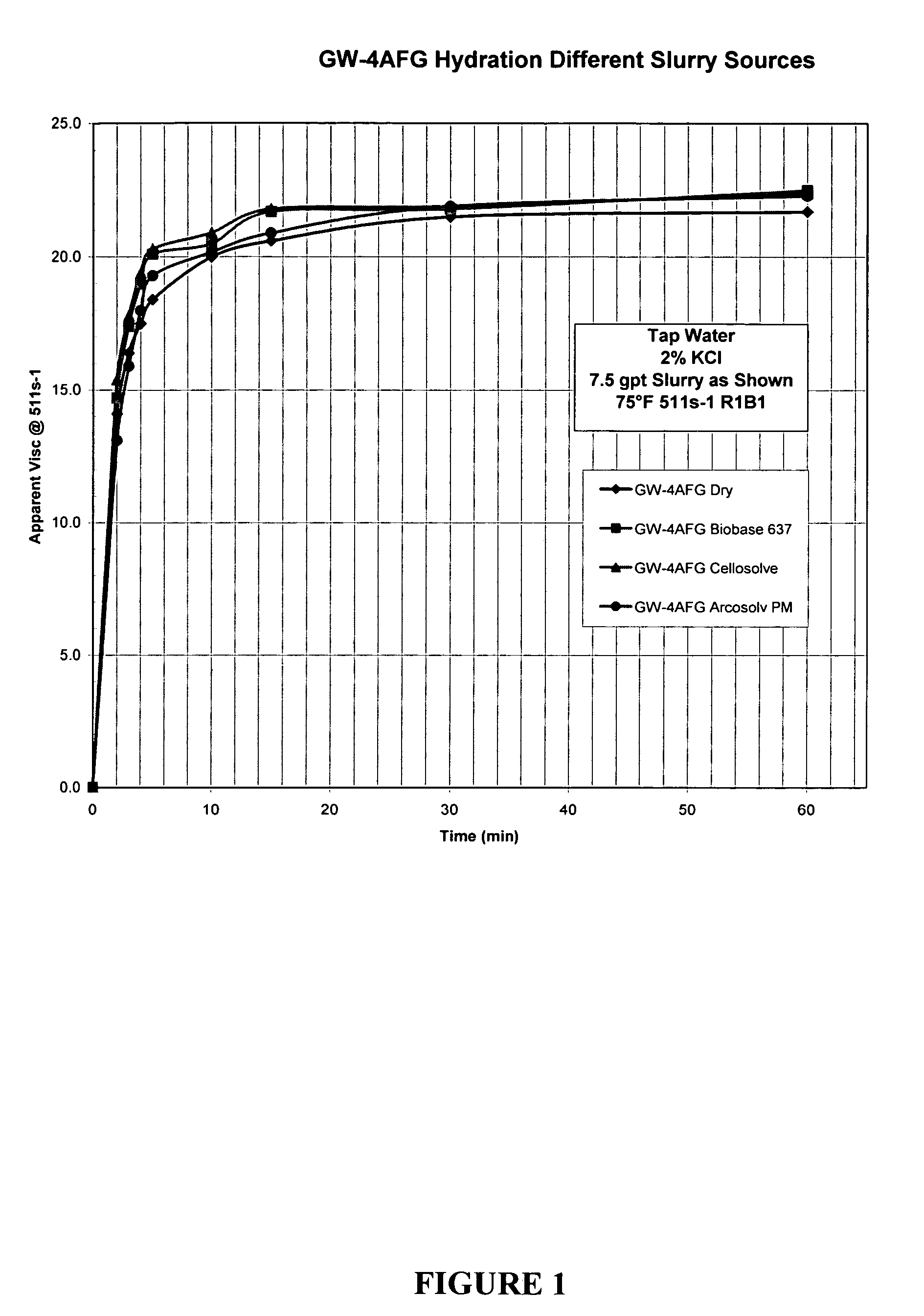Non-damaging fracturing fluids and methods for their use
a fracturing fluid, non-damaging technology, applied in the direction of sealing/packing, chemistry apparatus and processes, wellbore/well accessories, etc., can solve the problems of fracturing fluid meeting, reducing the conductivity of the proppant pack, and inability to us
- Summary
- Abstract
- Description
- Claims
- Application Information
AI Technical Summary
Problems solved by technology
Method used
Image
Examples
example 1
Preparation of a Slurry Composition for Use with Water-Based Fracturing Fluids
[0028] The slurry was prepared by adding 20 to 75 pounds of the highly substituted hydroxypropyl guar (GM-60, BJ Services Company, Houston, Tex.) per thousand gallons and 2 pounds of fumaric acid per thousand gallons in glycol ether (propylene glycol monomethyl ether, Arcosolv PM, Lyondell Chemical, Houston, Tex.). After the glycol ether is viscosified, 4 pounds per gallon of a water-soluble standard guar (GW-4, BJ Services Company, Houston, Tex.) is added. This polymer slurry is added to water at a loading of 7.5 gallons of slurry to 1000 gallons of water and allowed to hydrate under constant mixing for one hour. One (1) to five (5) gallons of an ethoxylated alcohol per thousand gallons was then added to the slurry to aid in water-soluble polymer dispersion and hydration upon contact with water.
[0029] Depending on the concentration of the GM-60, the viscosity of the slurry ranged from 100 cP to 350 cP a...
example 2
Preparation of a High pH Non-Aqueous Fracturing Fluid Using Borate Crosslinker
[0030] The base solvent was prepared as a blend of 87.5% vol. glycol ether (Cellosolv, Fisher Scientific) and 12.5% vol. methanol (technical grade, Fisher Scientific). Since most buffers used to adjust the pH are not soluble in glycol ethers, the addition of methanol makes the buffers compatible with the glycol ether. Highly substituted hydroxypropyl guar (GM-60) was added to the base solvent at a loading of 50 pounds per thousand gallons along with 2 pounds per thousand gallons fumaric acid to aid in hydration. The polymer was allowed to hydrate for 60 minutes with continuous agitation. One (1) gallon of CXB-10 (BJ Services), a combined borate crosslinker / pH adjuster having 2.7% boron, per thousand gallons was added to the hydrated polymer solution, resulting in an equivalent pH of 10.2. The resultant crosslinked gel was evaluated in a HPHT rheometer (FANN 50c) at a nitrogen pressure of 400 psi. The cros...
example 3
Preparation of a Low pH Non-Aqueous Formulation Using Zirconium Crosslinker
[0031] The base solvent was prepared as a blend of 87.5% vol. glycol ether (Arcosolv PM, Lyondell Chemical) and 12.5% vol. methanol (technical grade, Fisher Scientific). Highly substituted hydroxypropyl guar (GM-60) was added to the base solvent at a loading of 50 pounds per thousand gallons along with 2 pounds per thousand gallons fumaric acid to aid in hydration. The polymer was allowed to hydrate for 60 minutes with continuous agitation. Three (3) gallons of 90% wt. Formic acid per thousand gallons was added to the hydrated polymer solution, resulting in an equivalent pH of 3.8. Next, two (2) gallons XLW-12 (BJ Services), a zirconium crosslinker containing 6% Zr, per thousand gallons was added. The resultant crosslinked gel was evaluated in a HPHT rheometer (FANN 50c) at a nitrogen pressure of 400 psi. The crosslinked gel was heated to 200° F. at continuous shear of 100 sec-1. FIG. 2 displays the results,...
PUM
| Property | Measurement | Unit |
|---|---|---|
| concentration | aaaaa | aaaaa |
| viscosity | aaaaa | aaaaa |
| viscosity | aaaaa | aaaaa |
Abstract
Description
Claims
Application Information
 Login to View More
Login to View More - R&D
- Intellectual Property
- Life Sciences
- Materials
- Tech Scout
- Unparalleled Data Quality
- Higher Quality Content
- 60% Fewer Hallucinations
Browse by: Latest US Patents, China's latest patents, Technical Efficacy Thesaurus, Application Domain, Technology Topic, Popular Technical Reports.
© 2025 PatSnap. All rights reserved.Legal|Privacy policy|Modern Slavery Act Transparency Statement|Sitemap|About US| Contact US: help@patsnap.com


